Definisi
Mieloradikulopati adalah penyakit yang menyerang serabut saraf tulang belakang beserta tempat asal percabangan dari serabut saraf tersebut.
Istilah mieloradikulopati diambil dari kata “mielo” yang berasal dari kata mielin yang berarti serabut saraf, “radikulo” yang berasal dari kata radiks yang berarti tempat asal keluar percabangan saraf, dan “pati” yang berarti nyeri atau sakit. Bila nyeri hanya terjadi pada serabut saraf, maka istilah yang tepat untuk menggambarkan kondisi tersebut adalah “mielopati”, sedangkan bila nyeri terjadi di bagian tempat asal percabangan dari serabut saraf, maka istilah yang digunakan untuk menggambarkan kondisi tersebut adalah “radikulopati”.
Kondisi mieloradikulopati paling sering disebabkan akibat kompresi atau adanya tekanan pada sumsum tulang belakang, tekanan terus menerus yang terjadi dapat menyebabkan peradangan baik pada serabut saraf tulang belakang dan tempat keluarnya percabangan serabut saraf tersebut. Terdapat tiga jenis mieloradikulopati berdasarkan lokasi terjadinya peradangan, yakni mieloradikulopati servikal, mieloradikulopati torakal, dan mieloradikulopati lumbar.
Penyebab
Prinsip dasar dari terjadinya mieloradikulopati adalah peradangan pada serabut saraf tulang belakang dan tempat keluarnya percabangan serabut saraf tersebut. Namun, kondisi ini dapat disebabkan juga akibat adanya patah tulang belakang, infeksi, tumor, pengapuran tulang belakang, dan pertumbuhan abnormal pada tulang belakang.
Faktor risiko
Faktor risiko dari mieloradikulopati antara lain:
- Usia lanjut
- Jenis kelamin perempuan
- Tumor di bagian tulang belakang
- Kurang beraktivitas fisik dan olahraga
- Postur yang tidak baik saat bekerja dan berolahraga
- Membawa beban di punggung yang terlalu berat
- Kurangnya asupan kalsium
- Penggunaan bantal dan alas tidur yang tidak baik untuk tulang belakang
- Hernia nukleus pulposus
- Penyakit neurodegeneratif seperti parkinson atau amyotrophic lateral sclerosis
- Penyempitan pada rongga di tulang belakang
Gejala
Mieloradikulopati terbagi menjadi 3, yaitu:
- Mieloradikulopati servikal: Peradangan terjadi pada tulang servikal, yakni tulang yang berlokasi pada tempat keluar dan serabut saraf di leher. Gejala dari myeloradikulopati servikal adalah nyeri di leher, bahu, kelemahan otot, dan mati rasa yang menjalar dari bahu ke tangan.
- Myeloradikulopati torakal: Peradangan terjadi di tulang belakang bagian atas, menyebabkan gejala lebih berkonsentrasi pada nyeri dan mati rasa yang dapat menjalar dari tulang belakang ke tubuh bagian depan.
- Myeloradikulopati lumbar: Peradangan terjadi pada bagian bawah dari tulang belakang dan berhubungan dengan nyeri siatika.
Gejala umum dari mieloradikulopati di antaranya:
- Nyeri pada tulang belakang
- Mati rasa
- Kelemahan anggota gerak
- Kaku otot
- Kelemahan otot
- Sensasi panas di tulang belakang yang dapat menjalar ke tangan, bahu, atau kaki
- Penurunan fungsi kandung kemih atau fungsi usus
- Penurunan fungsi keseimbangan atau koordinasi
- Kesulitan untuk melakukan aktivitas sehari-hari seperti mengancing baju atau mengambil barang yang kecil
- Perubahan cara berjalan
Diagnosis
Dokter akan melakukan anamnesis atau wawancara tanya jawab dengan pasien, melakukan pemeriksaan fisik, dan pemeriksaan penunjang.
Anamnesis yang dilakukan akan menanyakan riwayat keluhan utama pasien, keluhan penyerta, sudah berapa lama pasien mengalami keluhan tersebut, adanya riwayat penyakit lain sebelumnya, adanya riwayat pengobatan tertentu, riwayat aktivitas fisik dan pekerjaan, serta riwayat penyakit di keluarga.
Kemudian proses penegakkan diagnosis dilakukan dengan melakukan pemeriksaan fisik. Pemeriksaan fisik yang dilakukan meliputi pemeriksaan umum guna memeriksa kesadaran pasien, tekanan darah, nadi, laju napas, dan suhu tubuh. Kemudian dokter akan melakukan pemeriksaan yang lebih spesifik yakni pemeriksaan saraf. Pemeriksaan dilakukan untuk melihat refleks saraf, fungsi motorik, sensorik, fungsi saraf wajah, kekakuan otot, dan fungsi keseimbangan tubuh.
Selanjutnya, dokter dapat merekomendasikan pemeriksaan penunjang untuk membantu menegakkan diagnosis. Pemeriksaan yang dapat dilakukan antara lain adalah pemeriksaan radiologi seperti X – Ray, CT Scan, atau MRI pada tulang belakang, pemeriksaan fungsi saraf dan otot seperti elektromiogram dan studi konduksi saraf. Semua pemeriksaan harus dilakukan berdasarkan rekomendasi dokter spesialis saraf.
Tata Laksana
Tata laksana yang dilakukan untuk myeloradikulopati bergantung dengan penyebab dari kondisi tersebut. Secara garis besar, tata laksana terbagi menjadi dua, yakni tata laksana nonpembedahan dan tata laksana pembedahan.
Tata laksana nonpembedahan
Tata laksana nonpembedahan meliputi pemberian obat-obatan tertentu untuk menurunkan gejala. Biasanya, jenis tata laksana ini diberikan bila gejala tidak terlalu berat. Obat yang dapat diberikan antara lain obat pengurang nyeri, obat pelemas otot agar otot tidak kaku, obat antiradang, antibiotik bila terdapat infeksi tertentu, terapi fisik untuk meregangkan otot tulang belakang, modifikasi gaya hidup dan aktivitas untuk memperbaiki postut tubuh, dan strategi penurunan berat badan bila pasien menderita obesitas. Tentunya pemberian obat harus dilakukan oleh dokter dan penggunaan harus diawasi.
Tata laksana pembedahan
Tata laksana pembedahan dapat menjadi pilihan bila dokter menemukan adanya penekanan pada serabut saraf tulang belakang beserta tempat keluarnya yang cukup parah. Jenis pembedahan yang dilakukan akan ditentukan oleh dokter spesialis bedah saraf. Tindakan yang dapat dilakukan antara lain adalah discectomy, laminectomy, foraminotomy, spinal fusion, dan operasi penggantian bantalan antar tulang belakang.
Jenis tindakan operasi yang dilakukan akan bergantung pada masalah dan penyebab dari terjadinya myeloradikulopati, dan dilakukan oleh dokter spesialis bedah saraf. Keberhasilan tindakan pembedahan akan bergantung kepada derajat keparahan penyakit, jenis kelamin pasien, usia pasien, teknologi pembedahan yang digunakan, dan durasi sejak keluhan tersebut muncul.
Komplikasi
Komplikasi dari mieloradikulopati adalah sebagai berikut:
- Kehilangan fungsi gerak pada bagian tulang belakang
- Nyeri leher terus menerus
- Nyeri tulang belakang terus menerus
- Nyeri kepala terus menerus
- Perubahan postur tubuh seperti kondisi lordosis atau kifosis, baik untuk sementara atau permanen
- Pembentukan tulang baru yang tidak semestinya (osteofit)
- Kerusakan saraf permanen
- Penurunan fungsi motorik dan sensorik permanen
Pencegahan
Terdapat beberapa upaya yang dapat diakukan untuk mencegah mieloradikulopati, seperti:
- Memperbaiki postur saat bekerja dan berolahraga
- Usahakan tidak membawa beban yang terlalu berat di punggung, pastikan beban terdistribusi secara merata
- Menggunakan bantal dan alas tidur yang baik untuk tulang belakang
- Melakukan peregangan otot secara berkala
- Mencukupi kebutuhan asupan kalsium
- Mengobati penyakit secara tuntas bila mengalami penyakit yang menjadi faktor risiko terjadinya myeloradikulopati seperti infeksi, tumor, dan hernia nukleus pulposus
- Memeriksakan diri secara rutin ke dokter spesialis saraf bila memang memiliki riwayat faktor risiko
- Hindari merokok
- Menjaga berat badan agar tidak terjadi obesitas
Kapan Harus ke Dokter?
Segeralah ke dokter bila Anda mengalami keluhan seperti yang sudah disebutkan di atas. Terutama bila terjadi adanya perubahan pada cara berjalan, fungsi keseimbangan, dan mati rasa. Anda dapat pergi ke dokter umum terlebih dahulu untuk melakukan pemeriksaan. Bila dokter umum mencurigai terjadinya mieloradikulopati dan membutuhkan penanganan lebih lanjut, maka dokter dapat memberikan tata laksana yang tepat dan merujuk ke dokter spesialis saraf.
Mau tahu informasi seputar penyakit lainnya? Cek di sini, ya!
- dr Ayu Munawaroh, MKK
Cleveland Clinic - Myelopathy. (2021). Retrieved 25 September 2022, from https://my.clevelandclinic.org/health/diseases/21966-myelopathy
John Hopkins Medicine - Myelopathy. (2021). Retrieved 25 September 2022, from https://www.hopkinsmedicine.org/health/conditions-and-diseases/myelopathy
John Hopkins Medicine - Radiculopathy. (2021). Retrieved 25 September 2022, from https://www.hopkinsmedicine.org/health/conditions-and-diseases/radiculopathy
Penn Medicine - Radiculopathy. (2021). Retrieved 25 September 2022, from https://www.pennmedicine.org/for-patients-and-visitors/patient-information/conditions-treated-a-to-z/radiculopathy












